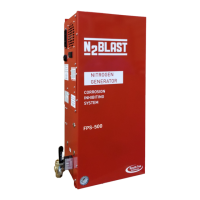Version: 1
Revision Date: 02/2018
N
2-BLAST
®
FPS-500
O&M Manual
Page: 20 of 25
Contact us Toll-Free: (888) 526-6284
for the next minute for any loss in pressure. If there is a pressure drop, check for leaks
around connection ttings, otherwise proceed to the next step.
8.
Open the tank inlet ball valve and the system will turn on and ll nitrogen to the storage tank.
9. Completely ll the storage tank and allow the nitrogen generator to go into standby mode.
10.
Once in standby mode, monitor the tank pressure gauge for 5 minutes and ensure no leaks
are in the tank. Open the tank outlet ball valve after verifying that there are no signicant leaks.
8.2 CHECKING FOR LEAKS
The Blast Off
®
provides early warning alarms for potential leakage. With a suspected leak, rst,
listen for leaks and spray soapy water around the connections. When a leak occurs, isolate the
area and relieve pressure before working on it. Fix the leaking part and return the system back to
operation. If no leak is heard (or bubbles visually seen with the soapy water), turn off the unit and
try isolating sections to see if there’s a pressure loss. Consult with your installer if you cannot nd
the leakage area.
8.2.1 To determine if the leak is between the Generator and the Nitrogen Tank:
1. With the unit powered on, close off both ball valves on the nitrogen tank. Note the storage
tank pressure.
2. Allow the system to continue running. Within 10 minutes or less, the system should reach
the “Standby” mode.
3. Wait 5 minutes and if the system remains in “standby” mode, then the leak is after the
nitrogen generator. Read the nitrogen tank pressure and if the pressure has changed, the
leak is within the storage tank ttings. If the nitrogen tank pressure did not change, check
the pipelines in the building for leaks.
4.
Returning to “run” mode indicates the leak is within the cabinet. Check lines back to the tank.

